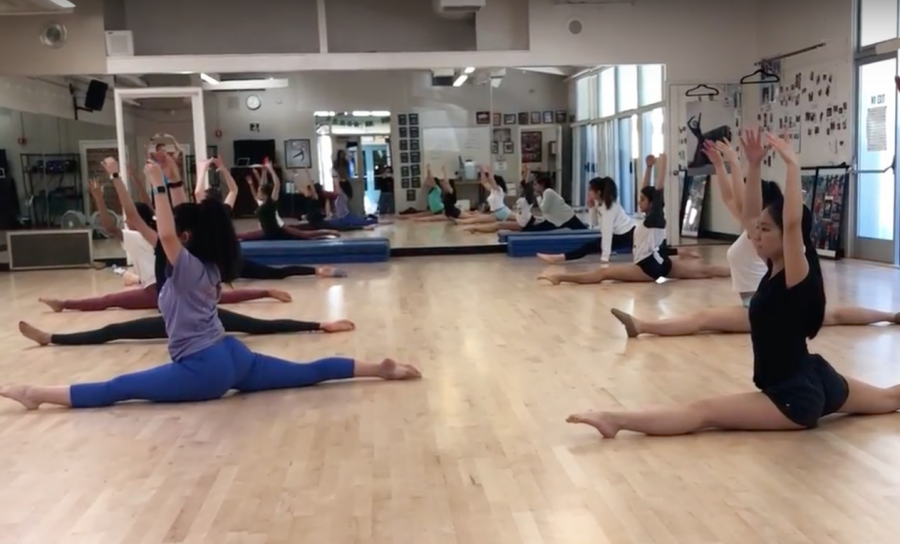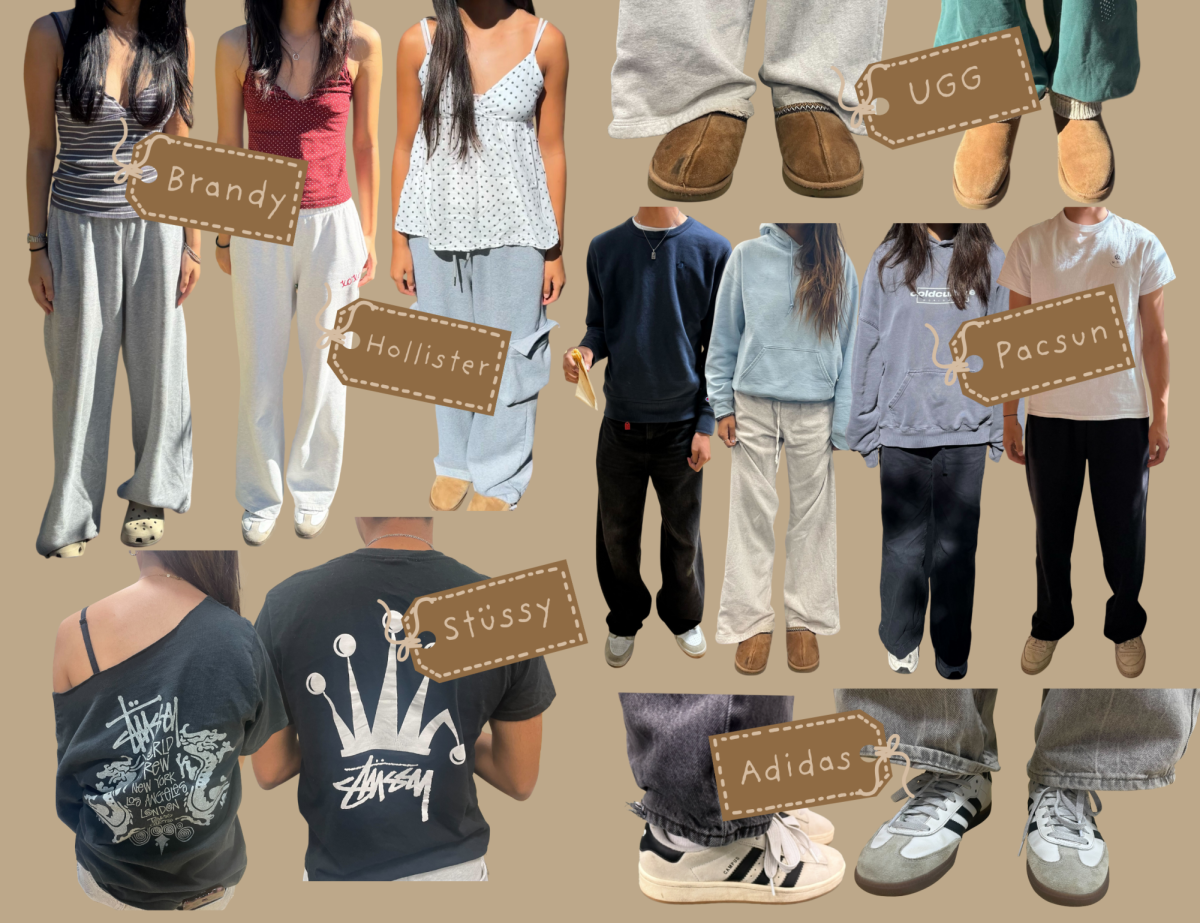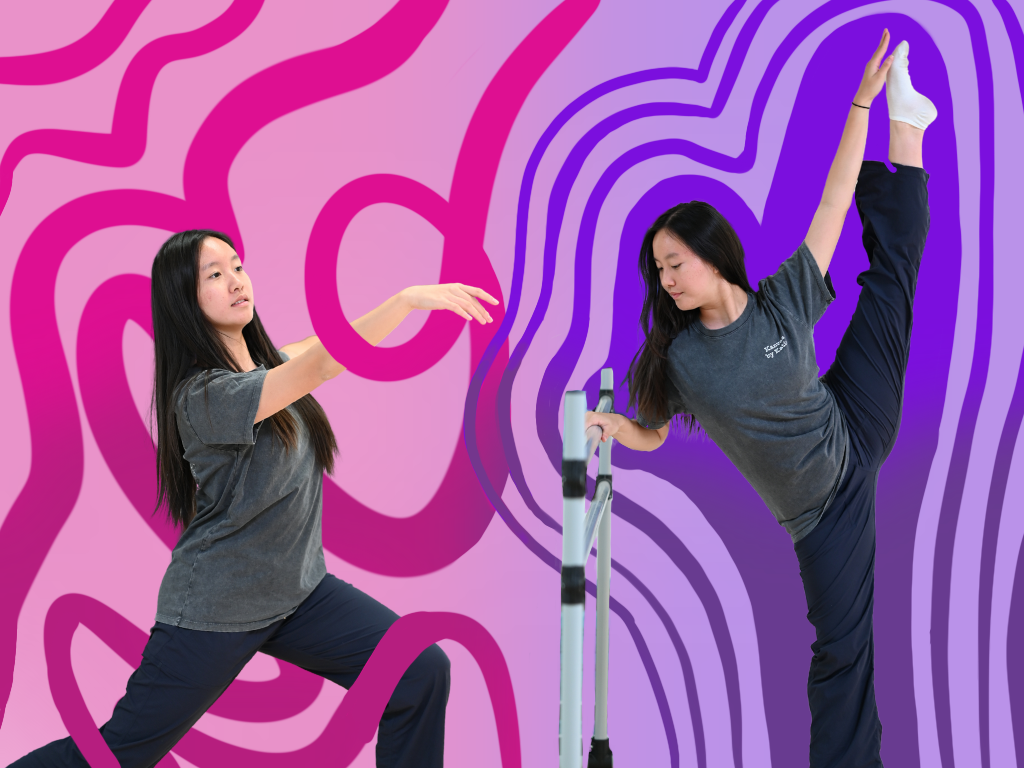Keeping up with the Kuehn Klass: Behind the scenes of after school dance classes
Dancers stretch out their splits in the “stretches, leaps and turns” after school class. This class, which started after the end of the annual dance show, was held on Tuesdays from 3:30 p.m. to 4:30 p.m.
May 27, 2019
Ambient white blocks of fluorescent lights line the angled ceiling, reflecting in the wall-length mirror of the dance room. Spread across the polished wooden floor in two straight rows, dancers in the Tuesday 3:30 p.m. to 4:30 pm. “stretch, leaps and turns” class sit in a straddled stretching position during the warm-up session. A remix version of “You’re The One That I Want” by Lo Fang envelops the room in upbeat music, blocking out the raucous background conversations at the daily ping-pong matches outside the door and the occasional voices of students walking past the open glass floor length doors.
Close to the mirrors up front, Karl Kuehn, Upper School Dance Teacher and Varsity Dance Team Director, positions into the next stretch as each dancer mimics his moves with precision and alert detail. Each dancer is lost in their own world of concentration, striving for a deeper stretch to loosen their muscles, warm their bodies and prevent possible injuries.
The class comprises of students from all grades: either dance team members who are required to participate or regular students who wish to maintain or improve flexibility and technique. Dance classes are therefore an effective method to keep pointed feet, flexible leaps and stable turns in tip top-shape.
To the beat of the music, the two rows of dancers pull their arms across their chests to ensure a deep stretch in the tendons and shoulders, followed by a slow release. While still in straddle, dancers follow their arm stretch by reaching forward, inch by inch, to their limit, slowly relaxing into the position. Straddle is a commonly used stretch that increases flexibility and mobility in the hamstrings, inner thighs, torso, shoulders, back, calves and feet, all important areas of the body utilized by dancers.
Reaching back up into a sitting position, the dancers each swing their right leg up and slide into their right splits, then follow with their left splits, making sure to keep their hips square so as to obtain the ultimate stretch. A deeply beneficial thigh and hip stretch, splits are the most commonly known stretch and skill known to dancers and non-dancers alike and are seen as the basic level of “flexibility.” This certain stretch is also a necessary skill to master what this class offers next: leaps.
After warm-ups, Kuehn arranges the students into columns for an activity known as “across the floors,” where, to the best of their ability while still maintaining technique, dancers execute exhilarating leaps such as grand jetés, a full split in mid-air and straddle. Another move practiced is the grand-battement. In either their socks or worn-out tan jazz shoes, dancers slide one pointed foot across the familiar wooden floor into a graceful high kick, eyes staring straight ahead in acute concentration while keeping in beat with the music.
While practicing both the right and left sides to the beat of the music, Kuehn counts in “5, 6, 7, 8” to cue the next row of dancers leaping across the floor. When each row has finished, panting breaths, sweating foreheads and flushed cheeks portray the effort and passion that each student in the room holds for dance.
Lastly, pirouettes, extremely technical turns that require a rigid posture, strong core and hours of practice. In the jazz pirouette taught at Harker’s dance class, rounded arms held in front and one leg is held in passé, where the thigh is brought up in parallel to the floor and the foot is pointed while held next to the supporting leg.
On the supporting leg, the foot must be in relevé, where the dancer’s only contact to the floor are the tips of their toes. While balancing in this position, dancers must then “spot” to maintain a flow of turns. When turning, the dancer is to continue to look at themselves in the mirror as much as possible while their body turns, then snap their head forward again to continue the momentum so as to ensure the most amount of turns.
Once again, Kuehn counts the dancers in with the familiar “5, 6, 7, 8” as each person preps the turn, bringing their legs up and whipping their heads as the whole class becomes a whirl of spinning tops, some more than others.
By the looks on the dancers’ and Kuehn’s faces, dance is truly an outlet for expression as well as a method of exercise and technique refinement. Classes create exposure to the dance world and motivate students’ self-improvement, which then leads many students to actively participate in dance for the following years, be it the annual dance show or trying out for the selected dance teams. To be able to see a physical improvement or fully portray themselves the way they want on stage, dancers truly rely on the grueling effort they put in after school dance classes, the effective behind-the-scenes of what perfects the “stretch, leaps and turns.”


















![“[Building nerf blasters] became this outlet of creativity for me that hasn't been matched by anything else. The process [of] making a build complete to your desire is such a painstakingly difficult process, but I've had to learn from [the skills needed from] soldering to proper painting. There's so many different options for everything, if you think about it, it exists. The best part is [that] if it doesn't exist, you can build it yourself," Ishaan Parate said.](https://harkeraquila.com/wp-content/uploads/2022/08/DSC_8149-900x604.jpg)




![“When I came into high school, I was ready to be a follower. But DECA was a game changer for me. It helped me overcome my fear of public speaking, and it's played such a major role in who I've become today. To be able to successfully lead a chapter of 150 students, an officer team and be one of the upperclassmen I once really admired is something I'm [really] proud of,” Anvitha Tummala ('21) said.](https://harkeraquila.com/wp-content/uploads/2021/07/Screen-Shot-2021-07-25-at-9.50.05-AM-900x594.png)







![“I think getting up in the morning and having a sense of purpose [is exciting]. I think without a certain amount of drive, life is kind of obsolete and mundane, and I think having that every single day is what makes each day unique and kind of makes life exciting,” Neymika Jain (12) said.](https://harkeraquila.com/wp-content/uploads/2017/06/Screen-Shot-2017-06-03-at-4.54.16-PM.png)








![“My slogan is ‘slow feet, don’t eat, and I’m hungry.’ You need to run fast to get where you are–you aren't going to get those championships if you aren't fast,” Angel Cervantes (12) said. “I want to do well in school on my tests and in track and win championships for my team. I live by that, [and] I can do that anywhere: in the classroom or on the field.”](https://harkeraquila.com/wp-content/uploads/2018/06/DSC5146-900x601.jpg)
![“[Volleyball has] taught me how to fall correctly, and another thing it taught is that you don’t have to be the best at something to be good at it. If you just hit the ball in a smart way, then it still scores points and you’re good at it. You could be a background player and still make a much bigger impact on the team than you would think,” Anya Gert (’20) said.](https://harkeraquila.com/wp-content/uploads/2020/06/AnnaGert_JinTuan_HoHPhotoEdited-600x900.jpeg)

![“I'm not nearly there yet, but [my confidence has] definitely been getting better since I was pretty shy and timid coming into Harker my freshman year. I know that there's a lot of people that are really confident in what they do, and I really admire them. Everyone's so driven and that has really pushed me to kind of try to find my own place in high school and be more confident,” Alyssa Huang (’20) said.](https://harkeraquila.com/wp-content/uploads/2020/06/AlyssaHuang_EmilyChen_HoHPhoto-900x749.jpeg)











